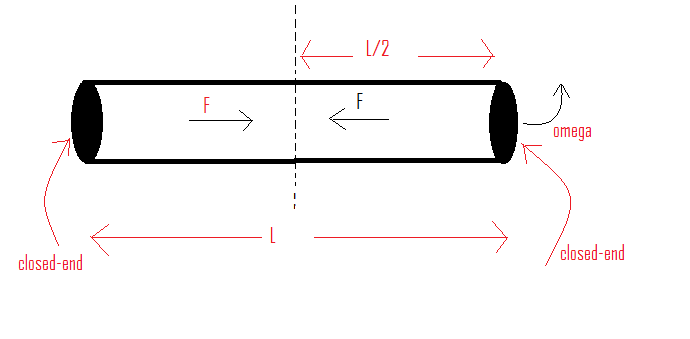
A tube of length L is filled completely with an incompressible liquid of mass M and closed at both ends. The tube is then rotated in a horizontal plane about one of its ends with uniform angular velocity $\omega $. The force exerted by the liquid at the other end is
A) $\dfrac{1}{2}M{\omega ^2}{L^2}$
B) $M{\omega ^2}L$
C) $\dfrac{1}{4}M{\omega ^2}L$
D) $\dfrac{1}{2}M{\omega ^2}L$
Answer
578.1k+ views
Hint: According to the question tube is rotated in a horizontal plane about one of its ends with uniform angular velocity $\omega$. Now, when force is applied at one end, then force acting on the other end is the centripetal force.
Formula used:
To solve this type of question we use the following formula.
Centrifugal force= $m{\omega ^2}r$, where $\omega$ is the angular frequency, $m$ is mass and $r$ is the distance the axes to the point of rotation where force is applied.
Complete step by step answer:

The formula of centrifugal force is $m{\omega ^2}r$.
Now, we know that the centre of mass will be at $\dfrac{L}{2}$.
Let us substitute the value in $m{\omega ^2}r$.
Centrifugal force=$m{\omega ^2} \times \dfrac{L}{2} = \dfrac{{mL{\omega ^2}}}{2}$
This is the force that will act on the other end of the tube.
$\therefore $ Hence, option (D) $\dfrac{{mL{\omega ^2}}}{2}$ is the correct option.
Additional information:
The centripetal force always acts perpendicular to the displacement direction. Consider an object accelerating with a change in velocity, the object will either change the direction of motion or the speed. This happens only in the centripetal force. If an object moves in a circular path and experiences an outward force then the object is said to be in the centrifugal force.
Note:
-A body performing circular motion is acted upon by a force which is always directed towards the center of the circle. This is called the centripetal force.
-Centrifugal force is a pseudo force. There are certain situations in which we feel that a body is acted upon by a force, but actually there is no force on the body.
-An effect that seems to cause an object moving in a curve to be pushed away from the curve’s center. This is called the centrifugal force.
Formula used:
To solve this type of question we use the following formula.
Centrifugal force= $m{\omega ^2}r$, where $\omega$ is the angular frequency, $m$ is mass and $r$ is the distance the axes to the point of rotation where force is applied.
Complete step by step answer:

The formula of centrifugal force is $m{\omega ^2}r$.
Now, we know that the centre of mass will be at $\dfrac{L}{2}$.
Let us substitute the value in $m{\omega ^2}r$.
Centrifugal force=$m{\omega ^2} \times \dfrac{L}{2} = \dfrac{{mL{\omega ^2}}}{2}$
This is the force that will act on the other end of the tube.
$\therefore $ Hence, option (D) $\dfrac{{mL{\omega ^2}}}{2}$ is the correct option.
Additional information:
The centripetal force always acts perpendicular to the displacement direction. Consider an object accelerating with a change in velocity, the object will either change the direction of motion or the speed. This happens only in the centripetal force. If an object moves in a circular path and experiences an outward force then the object is said to be in the centrifugal force.
Note:
-A body performing circular motion is acted upon by a force which is always directed towards the center of the circle. This is called the centripetal force.
-Centrifugal force is a pseudo force. There are certain situations in which we feel that a body is acted upon by a force, but actually there is no force on the body.
-An effect that seems to cause an object moving in a curve to be pushed away from the curve’s center. This is called the centrifugal force.
Recently Updated Pages
Why are manures considered better than fertilizers class 11 biology CBSE

Find the coordinates of the midpoint of the line segment class 11 maths CBSE

Distinguish between static friction limiting friction class 11 physics CBSE

The Chairman of the constituent Assembly was A Jawaharlal class 11 social science CBSE

The first National Commission on Labour NCL submitted class 11 social science CBSE

Number of all subshell of n + l 7 is A 4 B 5 C 6 D class 11 chemistry CBSE

Trending doubts
Differentiate between an exothermic and an endothermic class 11 chemistry CBSE

10 examples of friction in our daily life

One Metric ton is equal to kg A 10000 B 1000 C 100 class 11 physics CBSE

Difference Between Prokaryotic Cells and Eukaryotic Cells

1 Quintal is equal to a 110 kg b 10 kg c 100kg d 1000 class 11 physics CBSE

State the laws of reflection of light




